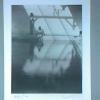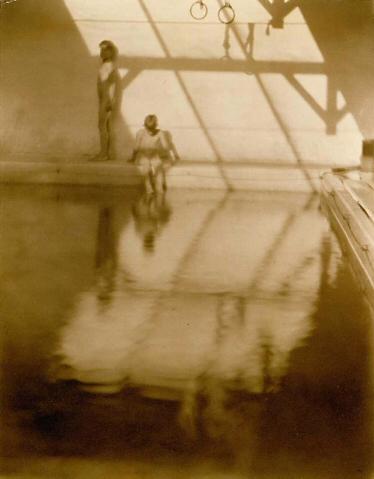A69.19.2
(24.13 cm HIGH x 19.05 cm WIDE)
This is a platinum print that shows two boys at an indoor pool. The boys appear in the distance at upper left in the image. The boy on the left stands in profile and looks over his left shoulder toward the camera. The second boy sits by the side of the pool gazing at the water and holding his feet just above the surface. The shadow of a paned window falls in a slant across the back wall at top right in the image. This shadow is also reflected on the surface of the pool, which appears in lower two-thirds of the image.
Handbook selection, 1984. On, August 24, 2006, Karen Christian, a descendant of the Bixby-Smiths, wrote Oakland Museum curator of photography Drew Johnson: "I Thought you might be interested to hear what I found out yesterday from my cousin Paul Jordan-Smith about that Edward Weston photograph entitled, "Bathing Pool."Paul confirmed my suspicion that the pool was at Sarah Bixby Smith's home in Claremont, California - definitely not in Irvine. Paul said the pool was located in the basement of the home. (If you look at the website of the City of Claremont, California, there's a photo of the old house. It was quite large, had been a boys' boarding school at one time.) Paul's father, Wilbur Jordan Smith, told him that when he and our Uncle Ralph were boys, Sarah's son, Roger Bixby Smith, who was several years older, liked to play pranks on them, and that to retaliate, the brothers one night put chili powder and hair clippings in Roger's bed. When Roger realized why he was itching so badly, he immediately knew who the culprits were, and he chased them downstairs and threw them in the pool. Plump little Uncle Ralph floated, but lanky and lean Uncle Wilbur deliberately sank to the bottom and a terrified Roger jumped in to rescue him. However, by the time Roger reached the bottom, Wilbur was standing poolside with his little brother, roaring with laughter!Paul also said Edward Weston took photos of Ralph and Wilbur, sans clothing, at the pool, and when I told him about the photo in your book (and Amy Conger's), he said he thought it might actually have been of these two rather than Chandler Weston and Llewellyn Bixby Smith. However, as I described the photo to Paul over the phone, he conceded it did not sound like the one he'd seen (a copy of which his father sold to the Getty Museum a number of years ago)." The only other known print of this image was sold at Butterfield & Butterfield on November 14, 1994. The sale catalog contains the following history of the image:"Bathing Pool," an important image from Edward Weston's early career in Los Angeles, represents the beginnings of his departure from pictorialism. . . . Weston understood the importance of this image almost immediately, as he chose to send it to England that year to the premier salon of the day, the London Salon.Weston exposed at least four negatives at the Bixby-Smith pool that day; the three versions that have been published indicate that two boys and a young man served as models (for published variants see "Edward Weston in Los Angeles," Henry E. Huntington Library, 1986, p. 10, and "Parallels and Contrasts: Photographs from the Stephen White Collection," New Orleans Museum of Art, pl. 118). The two young boys who are present in this print are thought to be Llewellyn Bixby-Smith and Chandler Weston, Edward's first son. Llewellyn was the son of Sarah Bixby, whose family owned a large ranch in Irvine, and the stepson of Paul Jordan Smith, a literary critic for the Los Angeles Times. Llewellyn and Chandler remained friends for many years (see "Daybooks" pp. 24, 27, 30).After the image was exhibited at the London Saloon, it traveled to the Albright Art Gallery in Buffalo (now called the Albright-Knox Art Gallery) for an exhibition titled "The First National Exhibition of Pictorial Photography: Under Direction of the Buffalo Camera Club" which ran from February 24 through March 30, 1920. . . .With so much attention focused on Weston's Mexican and later periods, and with the photographer's own interest in disavowing, if not destroying, most of his earliest work, it is no wonder that such an important early image was not recognized for many years. Also contributing to the decades of relative obscurity is the fact that the first known copy of "Bathing Pool" was not acquired by the Oakland Museum (from Imogen Cunningham) until 1969. It was not until 1984 that a group of prints, including all four variants, was discovered in the Bixby-Smith estate. . . . "Bathing Pool's" extensive modern day exhibition history in combination with the early exhibition of the print, are a testament to the importance of this image in the photographer's career and in the history of pictorialism. [Butterfield & Butterfield, San Francisco & Los Angeles, Sale 6115M, November 13, 1994].





